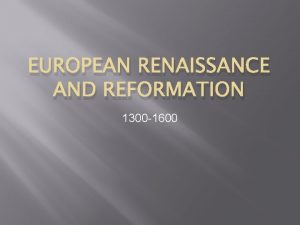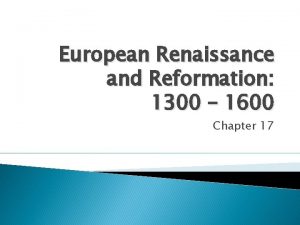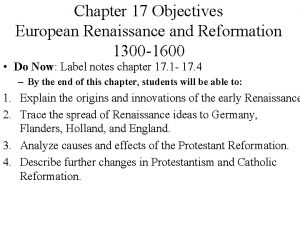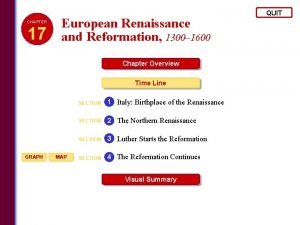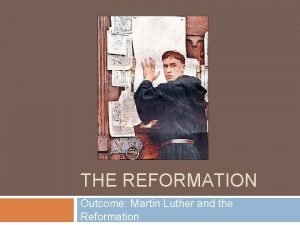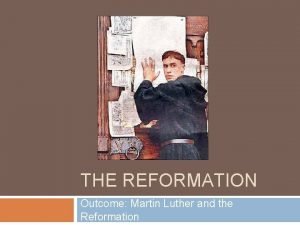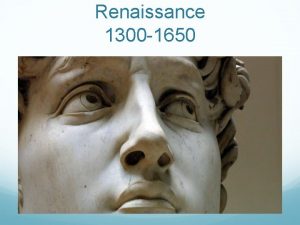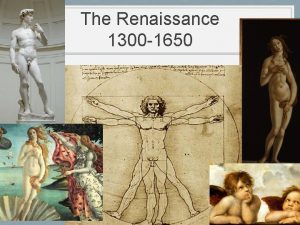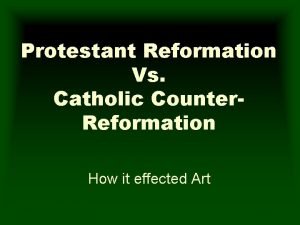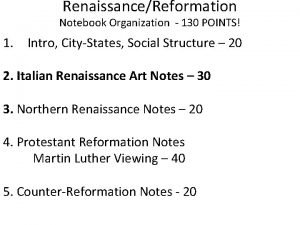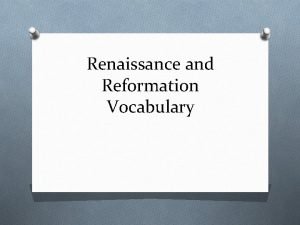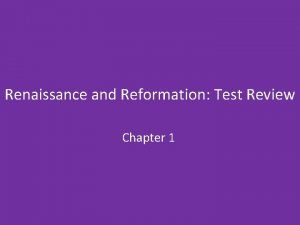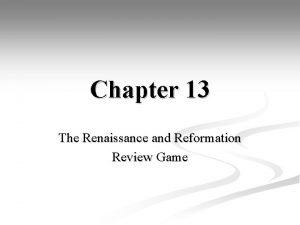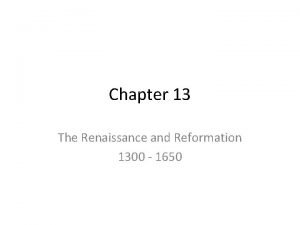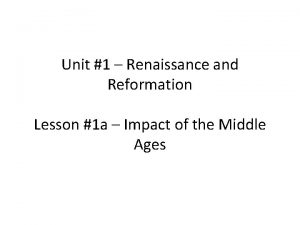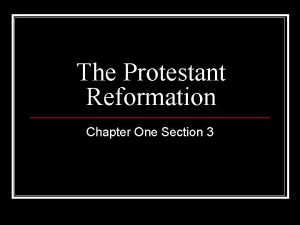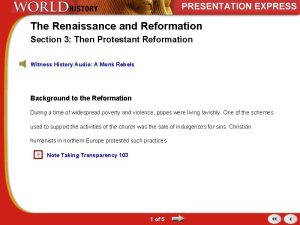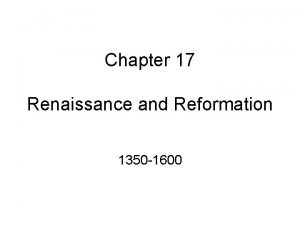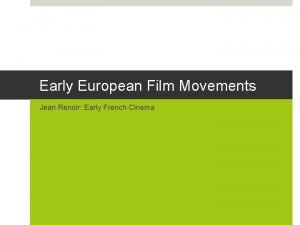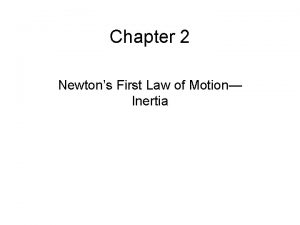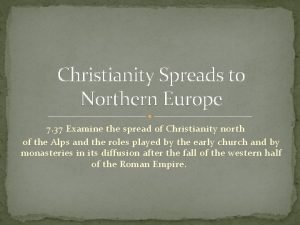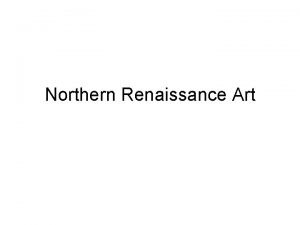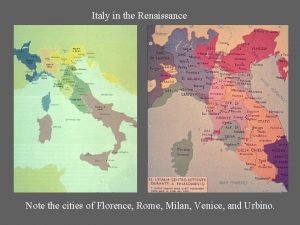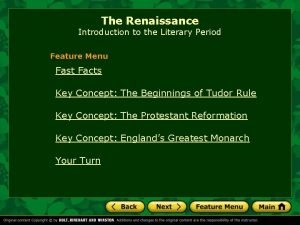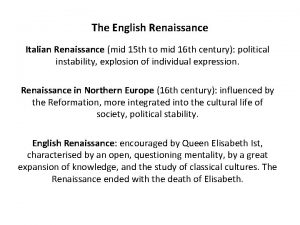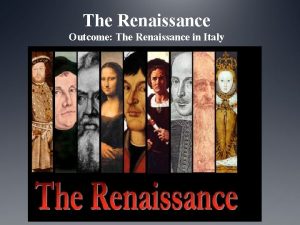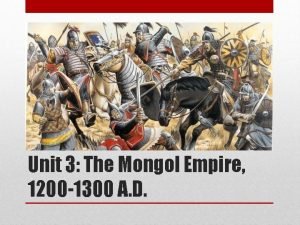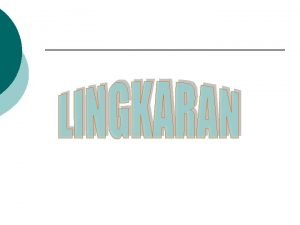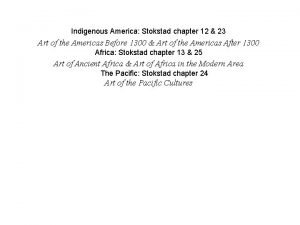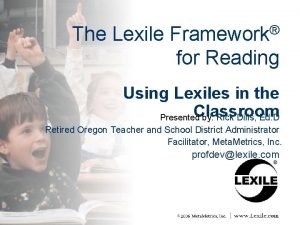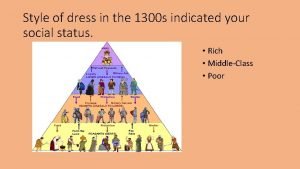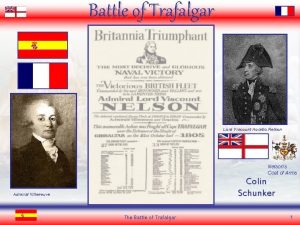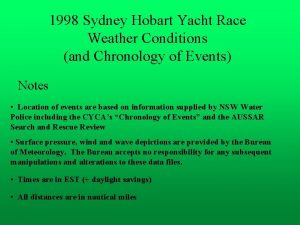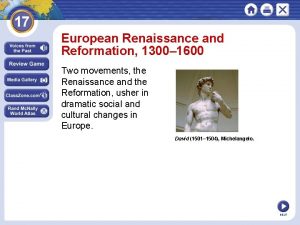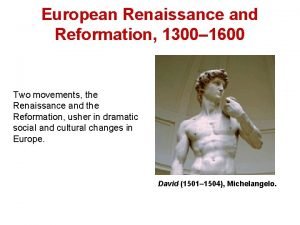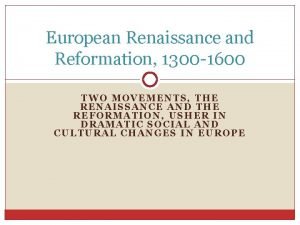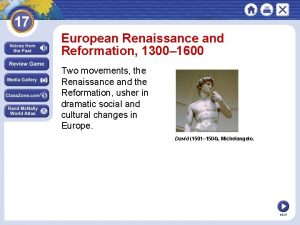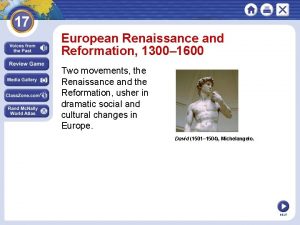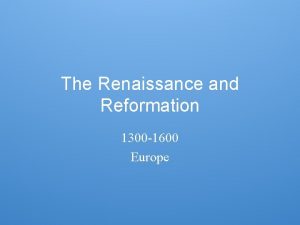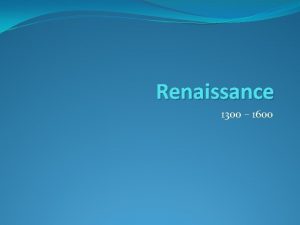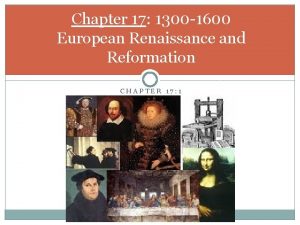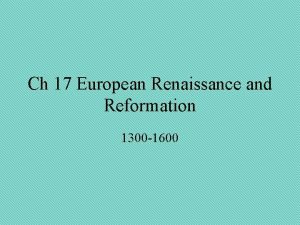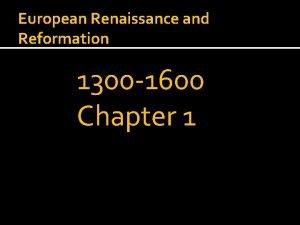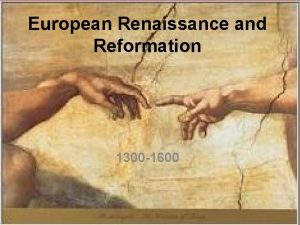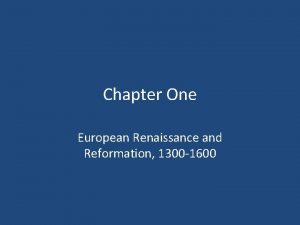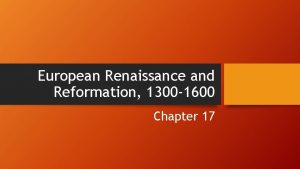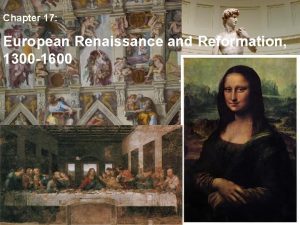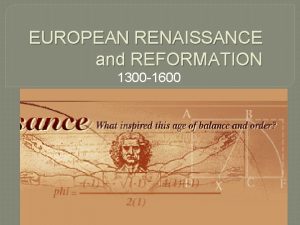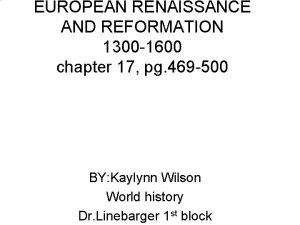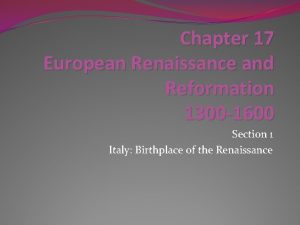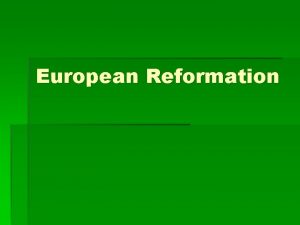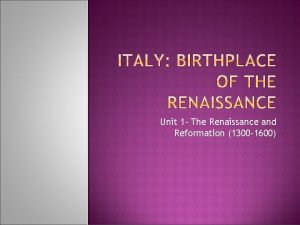European Renaissance and Reformation 1300 1600 Two movements










































- Slides: 42

European Renaissance and Reformation, 1300– 1600 Two movements, the Renaissance and the Reformation, usher in dramatic social and cultural changes in Europe. David (1501– 1504), Michelangelo. NEXT

European Renaissance and Reformation, 1300– 1600 SECTION 1 Italy: Birthplace of the Renaissance SECTION 2 The Northern Renaissance SECTION 3 Luther Leads the Reformation SECTION 4 The Reformation Continues Map Chart NEXT

Section 1 Italy: Birthplace of the Renaissance The Italian Renaissance is a rebirth of learning that produces many great works of art and literature. NEXT

SECTION 1 Italy: Birthplace of the Renaissance Italy’s Advantages The Renaissance • Renaissance—an explosion of creativity in art, writing, and thought • Started in northern Italy • Lasted from 1300– 1600 Map City-States • Crusades spur trade • Growth of city-states in northern Italy • In 1300 s bubonic plague killed 60% of population, disrupts economy Image Continued. . . NEXT

SECTION 1 continued Italy’s Advantages Merchants and the Medici • A wealthy merchant class develops • More emphasis on individual achievement • Banking family, the Medici, controls Florence Image Looking to Greece and Rome • Artists, scholars study ruins of Rome and Latin, Greek manuscripts • Scholars move to Rome after fall of Constantinople in 1453 NEXT

SECTION 1 Classical and Worldly Values Classics Lead to Humanism • Humanism—intellectual movement focused on human achievements • Humanists studied classical texts, history, literature, philosophy Worldly Pleasures • Renaissance society was secular—worldly • Wealthy enjoyed fine food, homes, clothes Continued. . . NEXT

SECTION 1 continued Classical and Worldly Values Patrons of the Arts • Patron—a financial supporter of artists • Church leaders spend money on artworks to beautify cities • Wealthy merchants also patrons of the arts The Renaissance Man • Excels in many fields: the classics, art, politics, combat • Baldassare Castiglione’s The Courtier (1528) • The book teaches how to become a “universal” person Continued. . . NEXT

SECTION 1 continued Classical and Worldly Values The Renaissance Woman • Upper-class, educated in classics, charming • Expected to inspire art but not create it • Isabella d’Este, patron of artists, wields power in Mantua Image NEXT

SECTION 1 The Renaissance Revolutionizes Artistic Styles Change • Artists use realistic style copied from classical art, often to portray religious subjects • Painters use perspective—a way to show three dimensions on a canvas Image Realistic Painting and Sculpture • Realistic portraits of prominent citizens • Sculpture shows natural postures and expressions • The biblical David is a favorite subject among sculptors Continued. . . NEXT

SECTION 1 continued The Renaissance Revolutionizes Art Leonardo, Renaissance Man • Leonardo da Vinci—painter, sculptor, inventor, scientist • Paints one of the best-known portraits in the world: the Mona Lisa • Famous religious painting: The Last Supper Image Raphael Advances Realism • Raphael Sanzio, famous for his use of perspective • Favorite subject: the Madonna and child • Famous painting: School of Athens Continued. . . NEXT

SECTION 1 continued The Renaissance Revolutionizes Art Anguissola and Gentileschi • Sofonisba Anguissola: first woman artist to gain world renown • Artemisia Gentileschi paints strong, heroic women Image NEXT

SECTION 1 Renaissance Writers Change Literature New Trends in Writing • Writers use the vernacular—their native language • Self-expression or to portray individuality of the subject Petrarch and Boccaccio • Francesco Petrarch, humanist and poet; woman named Laura is his muse • Boccaccio is best known for the Decameron, a series of stories Continued. . . NEXT

SECTION 1 continued Renaissance Writers Change Literature Machievelli Advises Rulers • Niccolò Machievelli, author of political guidebook, The Prince • The Prince examines how rulers can gain and keep power Vittoria Colonna • Woman writer with great influence • Poems express personal emotions NEXT

Section 2 The Northern Renaissance In the 1400 s, the ideas of the Italian Renaissance begin to spread to Northern Europe. NEXT

SECTION 2 The Northern Renaissance Begins Renaissance Ideas Spread • Spirit of Renaissance Italy impresses visitors from northern Europe • When Hundred Years’ War ends (1453), cities grow rapidly • Merchants in northern cities grow wealthy and sponsor artists • Northern Renaissance artists interested in realism • Humanists interested in social reform based on Judeo-Christian values NEXT

SECTION 2 Artistic Ideas Spread Renaissance Styles Migrate North • Artists, writers move to northern Europe fleeing war in Italy (1494) German Painters • Albrecht Dürer’s woodcuts and engravings emphasize realism • Hans Holbein the Younger paints portraits, often of English royalty Image Continued. . . NEXT

SECTION 2 continued Artistic Ideas Spread Flemish Painters • Flanders (located in present day France, Belgium and Netherlands) is the artistic center of northern Europe • Jan van Eyck, pioneer in oil-based painting, uses layers of paint • Van Eyck’s paintings are realistic and reveal subject’s personality • Pieter Bruegel captures scenes of peasant life with realistic details Map Image NEXT

SECTION 2 Northern Writers Try to Reform Society Northern Humanists • Criticize the Catholic Church, start Christian humanism • Want to reform society and promote education, particularly for women Christian Humanists • Desiderius Erasmus of Holland is best-known Christian humanist • His book, The Praise of Folly, pokes fun at merchants and priests • Thomas More of England creates a model society in his book Utopia Continued. . . NEXT

SECTION 2 continued Northern Writers Try to Reform Society Women’s Reforms • Christine de Pizan, one of the first women writers • She promotes education, equal treatment for boys and girls NEXT

SECTION 2 The Elizabethan Age Queen Elizabeth I • Renaissance spreads to England in mid-1500 s • Period known as the Elizabethan Age, after Queen Elizabeth I • Elizabeth reigns from 1558 to 1603 William Shakespeare • Shakespeare is often regarded as the greatest playwright • Born in Stratford-upon-Avon in 1564 • Plays performed at London’s Globe Theater NEXT

SECTION 2 Printing Spreads Renaissance Ideas Chinese Invention • Around 1045 Bi Sheng of China invents movable type • It uses a separate piece of type for each character Gutenberg Improves the Printing Process • Around 1440 Johann Gutenberg of Germany develops printing press • Printing press allows for quick, cheap book production • First book printed with movable type, Gutenberg Bible (1455) Image NEXT

SECTION 2 The Legacy of the Renaissance Changes in the Arts • • • Art influenced by classical Greece and Rome Realistic portrayals of individuals and nature Art is both secular and religious Writers use vernacular, or native language Art praises individual achievement Continued. . . NEXT

SECTION 2 continued The Legacy of the Renaissance Changes in Society • Printing makes information widely available • Illiterate people benefit by having books read to them • Published accounts of maps and charts lead to more discoveries • Published legal proceedings make rights clearer to people • Political structures and religious practices are questioned NEXT

Section 3 Luther Leads the Reformation Martin Luther’s protest over abuses in the Catholic Church lead to the founding of Protestant churches. NEXT

SECTION 3 Luther Leads the Reformation Causes of the Reformation Church Authority Challenged • Secularism, individualism of Renaissance challenge Church authority • Rulers challenge Church’s power • Printing press spreads secular ideas • Northern merchants resent paying church taxes Criticisms of the Catholic Church • Corrupt leaders, extravagant popes • Poorly educated priests Continued. . . NEXT

SECTION 3 continued Causes of the Reformation Early Calls for Reform • John Wycliffe and Jan Hus stress Bible’s authority over clergy’s • Desiderius Erasmus and Thomas More are vocal critics of the Church • Reading religious works, Europeans form own opinions about Church NEXT

SECTION 3 Luther Challenges the Church The 95 Theses • Martin Luther protests Friar Johann Tetzel’s selling of indulgences • Indulgence—a pardon releasing a person from penalty for a sin • In 1517 Luther posts his 95 Theses attacking “pardon-merchants” • Luther’s theses circulate throughout Germany • Luther launches the Reformation—a movement for religious reform • Reformation rejects pope’s authority Image Continued. . . NEXT

SECTION 3 continued Luther Challenges the Church Luther’s Teachings • People can win salvation by good works and faith • Christian teachings must be based on the Bible, not the pope • All people with faith are equal, can interpret Bible without priests NEXT

SECTION 3 The Response to Luther The Pope’s Threat • Pope Leo X issues decree threatening to excommunicate Luther (1520) • Luther’s rights of Church membership are taken away • Luther refuses to take back his statements and is excommunicated The Emperor’s Opposition • Charles V is Holy Roman Emperor • He issues Edict of Worms (1521), declaring Luther a heretic • Luther and followers begin a separate religious group—Lutherans Continued. . . NEXT

SECTION 3 continued The Response to Luther The Peasants’ Revolt • Inspired by Reformation, German peasants seek end to serfdom (1524) • Princes crush revolt; about 100, 000 people die Germany at War • Some princes side with Luther, become known as Protestants • Charles V fails to return rebellious princes to Catholic Church • Peace of Augsburg (1555)—each prince can decide religion of his state NEXT

SECTION 3 England Becomes Protestant Henry VIII Wants a Son • Henry has only daughter, needs male heir to rule England • Henry wants a divorce; Pope refuses to annul— set aside—his first marriage to Catherine of Aragon The Reformation Parliament • Parliament passes laws ending pope’s power in England • Henry remarries, becomes official head of England’s Church • Thomas More refuses to go against Catholic Church and is beheaded Image Continued. . . NEXT

SECTION 3 continued England Becomes Protestant Consequences of Henry’s Changes • Henry has six wives and three children • Religious turmoil follows Henry’s death (1547) • Protestantism under King Edward, then Catholicism under Queen Mary Elizabeth Restores Protestantism • Henry’s second daughter, Queen Elizabeth I, forms Anglican Church • Anglican Church is acceptable to moderate Catholics and Protestants Continued. . . NEXT

SECTION 3 continued England Becomes Protestant Elizabeth Faces Other Challenges • Some Protestants and Catholics oppose Elizabeth • Phillip II, Catholic King of Spain, threatens England • Elizabeth’s need for money brings conflict with Parliament NEXT

Section 4 The Reformation Continues As Protestant reformers divide over beliefs, the Catholic Church makes reforms. NEXT

SECTION 4 The Reformation Continues Calvin Continues the Reformation Religious Reform in Switzerland • Swiss priest Huldrych Zwingli calls for Church reforms (1520) • War breaks out between Catholics, Protestants; Zwingli killed (1531) Calvin Formalizes Protestant Ideas • John Calvin writes Institutes of the Christian Religion (1536): - we are sinful by nature and cannot earn salvation - God chooses who will be saved— predestination • Calvinism—religion based on Calvin’s teachings Continued. . . NEXT

SECTION 4 continued Calvin Continues the Reformation Calvin Leads the Reformation in Switzerland • Calvin says ideal government is theocracy—rule by religious leaders • Geneva becomes a strict Protestant theocracy led by Calvinism Spreads • John Knox brings Calvinism to Scotland, followers are Presbyterians • Church governed by laymen called presbyters, or elders • Calvin’s followers in France called Huguenots • Catholics massacre Huguenots in Paris (1572) Image NEXT

SECTION 4 Other Protestant Reformers The Anabaptists • Anabaptists believe in separation of church and state, oppose wars • Forerunners of Mennonites and Amish Woman’s Role in the Reformation • Marguerite of Navarre protected Calvin in France • Katrina Zell also protects reformers • Katherina von Bora, Luther’s wife, promotes equality in marriage NEXT

SECTION 4 The Catholic Reformation A Counter Reformation • Catholic Reformation—seeks to reform Catholic Church from within Ignatius of Loyola • Leading Catholic reformer • His Spiritual Exercises (1522) calls for meditation, prayer, and study • Pope creates Society of Jesus religious order, the Jesuits • Jesuits follow Ignatius, start schools, convert non. Christians Continued. . . NEXT

SECTION 4 continued The Catholic Reformation Reforming Popes • Pope Paul III and Pope Paul IV lead reforms • Paul III calls Council of Trent to lay out reforms: - Church’s interpretation of Bible is final - Christians need faith and good works for salvation - Bible and Church traditions equally important - Indulgences are valid expressions of faith • Use Inquisition to seek out heresy • Paul IV issues Index of Forbidden Books (1559); books burned Image NEXT

SECTION 4 The Legacy of the Reformation Religious and Social Effects of the Reformation Interactive • Catholic Church is unified; Protestant denominations grow • Catholics and Protestants create schools throughout Europe • Status of women does not improve Political Effects of the Reformation • Catholic Church’s power lessens, power of monarchs and states grow • Reformation’s questioning of beliefs brings intellectual ferment • Late 18 th century sees a new intellectual movement—the Enlightenment NEXT

This is the end of the chapter presentation of lecture notes. Click the HOME or EXIT button.

Print Slide Show 1. On the File menu, select Print 2. In the pop-up menu, select Microsoft Power. Point If the dialog box does not include this pop-up, continue to step 4 3. In the Print what box, choose the presentation format you want to print: slides, notes, handouts, or outline 4. Click the Print button to print the Power. Point presentation Print Text Version 1. Click the Print Text button below; a text file will open in Adobe Acrobat 2. On the File menu, select Print 3. Click the Print button to print the entire document, or select the pages you want to print Print Text BACK
 Renaissance rebirth
Renaissance rebirth Who wrote praise of folly
Who wrote praise of folly European renaissance and reformation answer key
European renaissance and reformation answer key Chapter 17 european renaissance and reformation
Chapter 17 european renaissance and reformation European renaissance and reformation chapter 17
European renaissance and reformation chapter 17 Chapter 17 european renaissance and reformation
Chapter 17 european renaissance and reformation The reformation outcome martin luther and the reformation
The reformation outcome martin luther and the reformation The reformation outcome martin luther and the reformation
The reformation outcome martin luther and the reformation 1650-1300
1650-1300 Renaissance timeline 1300 to 1650
Renaissance timeline 1300 to 1650 Protestant reformation vs counter reformation
Protestant reformation vs counter reformation Renaissance historical events
Renaissance historical events Lutheranism and calvinism
Lutheranism and calvinism Renaissance and reformation interactive notebook
Renaissance and reformation interactive notebook Renaissance and reformation vocabulary
Renaissance and reformation vocabulary Chapter 1 renaissance and reformation
Chapter 1 renaissance and reformation Chapter 13 renaissance and reformation
Chapter 13 renaissance and reformation Chapter 13 the renaissance and reformation
Chapter 13 the renaissance and reformation Unit 1 renaissance and reformation
Unit 1 renaissance and reformation Give up one’s views or beliefs
Give up one’s views or beliefs Chapter 12 renaissance and reformation worksheet answer key
Chapter 12 renaissance and reformation worksheet answer key The renaissance and reformation section 3 quiz
The renaissance and reformation section 3 quiz Chapter 17 renaissance and reformation
Chapter 17 renaissance and reformation List of locomotor movements
List of locomotor movements European film movements
European film movements Burl and paul have a total weight of 1300 n
Burl and paul have a total weight of 1300 n The renaissance outcome the renaissance in italy
The renaissance outcome the renaissance in italy Italian renaissance vs northern renaissance venn diagram
Italian renaissance vs northern renaissance venn diagram The renaissance outcome renaissance painters/sculptors
The renaissance outcome renaissance painters/sculptors Flemish renaissance art characteristics
Flemish renaissance art characteristics Last supper labeled
Last supper labeled The renaissance introduction to the renaissance answer key
The renaissance introduction to the renaissance answer key Italian renaissance vs english renaissance
Italian renaissance vs english renaissance The renaissance outcome the renaissance in italy
The renaissance outcome the renaissance in italy What did the mongols do for the silk road
What did the mongols do for the silk road Sudut segi n beraturan
Sudut segi n beraturan Jumlah sudut segi n
Jumlah sudut segi n Art of the americas before 1300
Art of the americas before 1300 Axgate 80
Axgate 80 Lexile range by grade level
Lexile range by grade level 1300 dress
1300 dress 1300 hrs
1300 hrs 1300 hrs
1300 hrs

